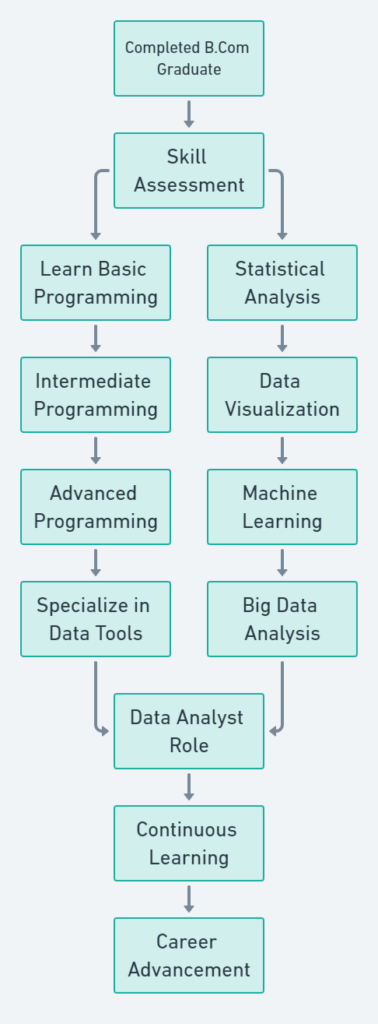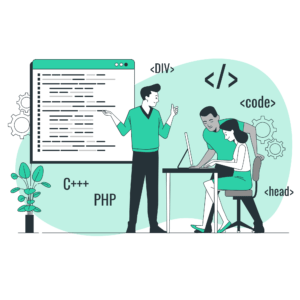Hey future data analysts! Ever wondered how your B.Com subjects can catapult you into the world of data analytics? Let’s explore how each subject you’ve mastered can become a superpower in the data-driven universe.
Table of Contents
B.Com Syllabus – Your Launchpad to Data Analytics
| B.Com Subjects | Relevance in Data Analytics |
|---|---|
| Financial Accounting | Dive into financial data like a pro! Use your accounting skills to unravel financial insights and guide key business decisions. |
| Business Law & Company Law | Be the guardian of data ethics! Your knowledge of laws helps ensure data is handled with utmost privacy and compliance. |
| Business Mathematics and Statistics | Numbers are your best friends! Apply your math and stats wizardry to extract meaningful insights from data. |
| Income Tax Law and Practice | Navigate the complex world of tax data like a champ! Use your tax law expertise to devise savvy tax strategies and ensure compliance. |
| Computer Applications in Business | Tech-savvy much? Leverage your IT skills to work wonders with data tools and programming languages. |
| Microeconomics & Sales Management | Understand the market pulse! Analyze customer data, predict trends, and forecast demand like a market guru. |
| Government & Business and CSR | Policy whiz-kid! Use data to gauge the impact of government policies and CSR initiatives on business. |
| Cost Accounting | Cut costs smartly! Your cost accounting skills help analyze and optimize expenses through data. |
| Indian Financial System | Decode financial markets! Your knowledge here helps you make sense of complex financial data. |
| Entrepreneurship Development and Business Ethics | Innovate and stay ethical! Blend your entrepreneurial spirit with data skills for groundbreaking insights. |
| Business Finance | Financial guru alert! Evaluate company performance and make informed investment decisions with data. |
| Management Accounting | Turn data into stories! Craft easy-to-understand reports from complex data sets to guide management. |
| Office Management | Streamline like a boss! Use data analytics to enhance office productivity and processes. |
| Dissertation/ Viva Voice | Research master! Apply these skills to dig deep into data, uncover trends, and communicate your findings effectively. |
| Elective Subjects | Your unique edge! Combine your specialized knowledge with data skills to stand out in the analytics field. |
See how your B.Com syllabus is not just about commerce but a treasure trove for budding data analysts? Each subject you’ve aced is a stepping stone into the fascinating world of data analytics. So, gear up and get ready to make a mark with your unique blend of commerce and analytics skills. The data universe awaits your exploration!
Got a B.Com background and a knack for data? Share your experiences or thoughts on how you plan to bridge these worlds. Let’s chat in the comments below!
How to Pave Your Way to a Data Analyst Role Post B.Com: An Intersection of Commerce and Data Analytics
Let’s dissect how some key topics from your B.Com syllabus can bolster your data analytics aspirations and help you navigate this new territory. You can even check out our courses for the same.

Data’s Tryst with Financial Accounting
Turning Financial Savvy into Data Insights:
- Categorizing Data: Just like you sort financial transactions into various accounts, in data analytics, you’ll classify data into different segments. Example: Grouping customers based on purchasing behavior, similar to categorizing expenses and revenues.
- Analyzing for Trends: Extracting key patterns from financial statements is akin to analyzing data trends. Example: Identifying seasonal sales trends from transaction data, mirroring how you’d spot financial trends in quarterly reports.
- Storytelling with Numbers: Conveying financial health to stakeholders is similar to illustrating data-driven narratives. Example: Presenting how marketing strategies impact sales, akin to explaining a balance sheet to investors.

Business Law: A Rulebook for Data Ethics
Navigating Data’s Legal Landscape:
- Ensuring Data Privacy: Your knowledge of legalities in business law translates to maintaining data privacy. Example: Implementing GDPR principles in data handling.
- Contract Law Application: Understanding nuances of contract law aids in managing data agreements. Example: Drafting data sharing agreements with vendors, ensuring compliance with legal standards.
- Compliance and Governance: Using your legal acumen to keep data practices compliant. Example: Ensuring company data policies adhere to national and international data protection laws.
Bridging B. Com and Data Analytics with Business Mathematics and Statistics
Leveraging Numbers for Predictive Insights:
- Statistical Analysis: Utilize your statistical knowledge for data interpretation. Example: Employing regression analysis to predict future sales trends.
- Mathematical Modelling: Applying mathematical techniques to build predictive models. Example: Using probability distributions to assess risk in investment portfolios.
- Data-Driven Decisions: Turn statistical findings into actionable insights. Example: Analyzing customer churn rates to develop retention strategies.
The Interplay of Computer Applications in Business and Data Analysis
From Basic Apps to Advanced Analytics Tools:
- Excel to Python/R Transition: Harness Excel skills as a foundation for learning Python/R for data analysis. Example: Transitioning from Excel spreadsheets to Python scripts for complex data manipulation.
- Visualizing Data: Transform data into understandable visuals. Example: Creating dashboards in tools like Tableau, similar to crafting PowerPoint presentations for business reports.
- Effective Data Management: Utilize database management skills for efficient data storage and retrieval. Example: Managing customer data in SQL databases, similar to organizing files and folders in a business setting.
Understanding the Market with Microeconomics & Statistics
Microeconomics & Statistics in Action:
- Market Trend Analysis: Utilize microeconomic theories to interpret market trends. Example: Analyzing consumer behavior shifts during economic downturns.
- Consumer Behavior Prediction: Apply statistical methods to predict buying patterns. Example: Using regression analysis to forecast how price changes influence demand.
- Pricing Strategy Development: Leverage your understanding of supply and demand to devise effective pricing strategies. Example: Employing elasticity concepts to set optimal pricing points.
“Understanding market dynamics through microeconomics and statistics is key to successful data analysis in business.”
Turning Sales Management Into Data-Driven Strategy
Sales Knowledge as a Data Tool:
- Customer Segmentation: Use your sales management insights to segment customers based on purchasing behavior. Example: Creating targeted marketing campaigns for different customer demographics.
- Behavior Prediction: Analyze sales data to predict future customer actions. Example: Identifying potential upsell opportunities based on past purchases.
- Sales Forecasting: Combine sales knowledge with data analytics for accurate sales predictions. Example: Using historical sales data to forecast future revenue during peak seasons.
“Transforming sales strategies with data-driven insights leads to smarter, more effective decision-making.”
Government & Business: Framing Policies with Data
Policy Analysis Through Data:
- Impact Assessment: Evaluate how government policies affect business operations. Example: Analyzing the effect of tax changes on small business profitability.
- Predictive Modeling: Use data to forecast the impact of potential policy changes. Example: Simulating the effects of new environmental regulations on manufacturing sectors.
- Regulatory Navigation: Assist businesses in adapting to new regulations. Example: Developing strategies to comply with new data privacy laws.
“Data analytics offers a powerful lens through which to view the intersection of government policy and business strategy.”
Cost Accounting Meets Data Analytics
Cost Tracking and Optimization:
- Trend Identification: Use cost data to spot spending trends and inefficiencies. Example: Detecting areas of excessive expenditure in production processes.
- Cost-Benefit Analysis: Apply analytical skills to weigh the financial pros and cons of business decisions. Example: Evaluating the ROI of investing in new technology.
- Recommendations for Reduction: Provide data-backed suggestions for cost-saving measures. Example: Identifying underperforming products or services to discontinue.
“Marrying cost accounting principles with data analytics leads to more efficient and profitable business operations.”
Indian Financial System and Data Insights
Navigating Financial Data: Data Analyst Role Post B.Com
- Economic Indicator Analysis: Interpret data to understand broader economic trends. Example: Analyzing GDP growth data to predict market opportunities.
- Stock Market Insights: Use financial market knowledge for investment analytics. Example: Evaluating stock performance patterns to guide investment decisions.
- Investment Data Interpretation: Translate complex financial data into understandable insights. Example: Assessing mutual fund performance data for portfolio optimization.
“Financial data analysis is about finding the story behind the numbers in the complex world of finance.”
Embracing Entrepreneurship Development and Business Ethics
Innovative and Ethical Data Use:
- Creative Problem-Solving: Apply entrepreneurial thinking to data challenges. Example: Developing novel ways to use data for customer engagement.
- Ethical Data Handling: Ensure that data practices align with ethical standards. Example: Implementing fair data processing practices to maintain user trust.
- Innovative Strategy Development: Use entrepreneurial skills to drive data-based innovation. Example: Creating new business models based on data-driven market insights.
Inculcating Corporate Social Responsibility (CSR) in Data Practices
Responsible Data Management:
- Ethical Data Usage: Promote the ethical application of data analytics. Example: Ensuring data privacy and security in all analytical processes.
- CSR Data Analysis: Use data to evaluate and enhance CSR initiatives. Example: Measuring the impact of a company’s sustainability efforts on brand perception.
- Positive Corporate Imaging: Shape corporate image through responsible data practices. Example: Using data to support community-oriented projects and reporting on CSR activities.
The Microeconomics of Data Analysis : Data Analyst Role Post B.Com
Applying Microeconomic Principles to Data:
- Customer Segmentation: Utilize microeconomic concepts to segment customers based on preferences, income levels, or buying habits. Example: Identifying target market segments for a new product launch based on consumer spending patterns.
- Price Elasticity Analysis: Apply the principle of elasticity to understand how price changes affect demand. Example: Adjusting pricing strategies for an e-commerce platform based on elasticity analysis of different product categories.
- Demand Forecasting: Use your understanding of market dynamics for accurate demand prediction. Example: Forecasting future sales for a seasonal product by analyzing past sales trends and market conditions.
“Leveraging microeconomics in data analytics allows for a nuanced understanding of market forces and consumer behavior.”
Translating Business Finance into Data Science
Integrating Financial Acumen with Data:
- Financial Performance Evaluation: Analyze financial data to assess a company’s health. Example: Using data analytics to evaluate a company’s profitability and cash flow trends over time.
- Risk Assessment: Apply financial principles to identify and assess business risks. Example: Conducting a data-driven risk analysis for potential investments or business expansions.
- Strategic Financial Decisions: Use data to inform key financial decisions. Example: Analyzing market trends and financial reports to guide merger and acquisition strategies.
“Combining business finance with data science transforms raw financial data into actionable business intelligence.”
Taxation and Analytics the must needed skill of data analyst
Tax Knowledge in Data Analysis:
- Tax Data Analysis: Leverage your understanding of taxation to analyze tax-related data. Example: Examining the effectiveness of tax incentives on business investment decisions.
- Developing Tax Strategies: Use analytics to devise efficient tax strategies for businesses. Example: Using predictive models to optimize tax planning and reduce liabilities.
- Regulatory Compliance: Ensure tax compliance through data-driven insights. Example: Analyzing transaction data to ensure adherence to VAT/GST regulations and other tax laws.
“Data analytics in taxation is not just about compliance; it’s about strategically leveraging tax data for business optimization.”
Using Management Accounting with Data as a data analyst
Transforming Data into Strategic Business Insights:
- Management Reporting: Convert complex financial data into clear management reports. Example: Using data visualization tools to present quarterly revenue trends and cost analysis.
- Informed Decision Making: Aid strategic decision-making with timely data insights. Example: Providing data-backed recommendations for budget allocations or investment opportunities.
- Driving Business Strategy: Utilize your accounting knowledge to influence and shape business strategies. Example: Analyzing profitability ratios and market trends to develop long-term business plans.
“Management accounting in the data era is about translating numbers into narratives that guide business strategy.”
Office Management as a skill of data analyst in the Age of Data
Enhancing Workplace Efficiency with Analytics:
- Process Optimization: Apply data analytics to streamline office operations. Example: Using workflow analysis to identify bottlenecks and improve process efficiency.
- Productivity Enhancement: Leverage data to boost office productivity. Example: Analyzing employee performance data to optimize workload distribution and enhance team productivity.
- Data-Driven Office Solutions: Transform traditional office management with modern data solutions. Example: Implementing data-based scheduling tools to improve meeting efficiency and resource allocation.
“Incorporating data analytics into office management revolutionizes traditional practices, leading to smarter, more efficient workplaces.”
Dissertation/ Viva Voice and Data Storytelling an important skill of data analyst
From Academic Research to Data Exploration:
- Research and Analysis: Apply your dissertation research skills to data exploration and analysis. Example: Conducting market research using data analytics to uncover consumer trends.
- Effective Communication: Use your viva voice experience to present data insights compellingly. Example: Crafting engaging data stories to communicate complex analysis to non-technical stakeholders.
- Idea Defense and Presentation: Translate your defense skills into convincing data-driven arguments. Example: Presenting and justifying analytical findings to support business decisions.Data Analyst Role Post B.Com
“The journey from academic research to data storytelling is about turning data into compelling narratives that drive action and understanding.”
Elective Subjects: Your Unique Advantage for being data analyst
Specialized Knowledge as a Data Edge:
- Diverse Perspectives: Harness your elective expertise for unique data insights. Example: Applying Intellectual Property Law knowledge to analyze data in technology firms.
- Tailored Analytics: Blend your specialized subject knowledge with analytics. Example: Utilizing Financial Risk Management principles to assess investment risks through data.
- Added Business Value: Provide specialized data analysis services. Example: Offering unique data solutions in niche markets, based on your elective expertise.
“Your elective subjects aren’t just additional knowledge – they’re a unique lens through which to view and analyze data.”
Now to conclude,
Frequently Asked Questions for Non-IT people to become data analyst
Can a B.Com Graduate Really Thrive in Data Analytics?
Absolutely! Your B.Com background gives you a solid foundation in financial principles, statistical analysis, and business acumen, all of which are highly valuable in data analytics. With additional learning in data tools and techniques, you can excel in this field.
What Additional Skills Should I Learn to Transition into Data Analytics?
To make the transition smoother, focus on learning data analytics tools like Python or R, database management with SQL, and data visualization tools such as Tableau or Power BI. Understanding the basics of machine learning can also be advantageous.
How Do I Start My Journey in Data Analytics with a B.Com Background?
Begin by exploring online courses or workshops in data analytics and statistics. Engage in real-world projects or internships to gain practical experience. Participating in online data challenges can also boost your skills and confidence.
Are There Specific Industries Where a B.Com Graduate Can Excel as a Data Analyst?
Yes, industries like finance, retail, e-commerce, and marketing, which heavily rely on financial and customer data, are ideal. Your commerce background can provide unique insights in these areas.
How Can I Showcase My B.Com Skills in a Data Analytics Job Application?
Highlight your understanding of business operations, financial acumen, and analytical skills. Tailor your resume to showcase projects or coursework that involved data analysis, and don’t forget to include any additional certifications or courses you’ve completed in data analytics.





